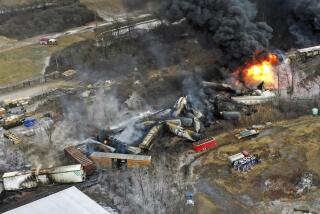Metrolink engineers must slow near possible red lights
Metrolink officials said Monday that they have ordered engineers to slow down as they approach possible red lights, a new safety regulation that comes shortly after two trains collided in Rialto and two months after a fatal head-on crash in Chatsworth killed 25.
Under the rule, which was put in place Friday, Metrolink trains must immediately slow to 40 mph or less when they are alerted that a light ahead may be red, the agency said.
The disclosure of the change in safety guidelines came the same day that the lead investigator in the federal probe of Thursday’s crash, in which a Metrolink train was going nearly 70 mph before it ran a red light and sideswiped a freight train, said the engineer may have violated an internal policy requiring him to announce over the radio that he was approaching the red light.
Metrolink engineers are required to call out all signal colors over the radio to alert other crew members, as well as other trains operating in the area, about the lights, according to agency regulations. It was not immediately clear whether failing to call out the signal contributed to the collision, investigators said.
The engineer operating the Metrolink train announced a flashing yellow light before the Rialto station and a solid yellow light just past the depot, said Ted Turpin, the National Transportation Safety Board investigator supervising the crash inquiry. The solid yellow signal would have alerted the crew that they had a stop light two miles ahead.
In interviews with investigators, the Metrolink engineer and a second crew member in the cab said they discussed the light but did not announce it over the radio because they were trying to hit their brakes to avoid ramming the other train.
“They said they were too busy trying to stop the train,” Turpin said.
He said investigators would conduct tests to determine why the crew failed to stop the train in time. The commuter train was allowed to go up to 79 mph that day, Turpin said.
The NTSB probe is focusing on possible human error or brake failure, although one test showed that the brakes were functioning properly, Turpin said. More testing on the brake system is needed, he said.
Thursday’s accident, which injured five people, was the second time in less than three months that a Metrolink engineer failed to announce a red light before hitting a freight train.
Investigators probing the fatal Chatsworth collision in September have said the engineer and conductor failed to communicate a red light before colliding with an oncoming freight train.
Shortly after that accident, the private contractor that operates Metrolink trains sent out a safety alert reminding employees that they “must communicate all signals and their locations via radio,” according to a copy of the internal memo obtained by The Times.
“One of the advantages of calling signals via radio is for other trains in that area to hear and compare that information to what they are running on,” the memo said.
Turpin said it would take up to nine months before a probable cause is determined in the Rialto crash.
Also Monday, U.S. Sen. Dianne Feinstein called on the Federal Railroad Administration to expedite approvals for new collision avoidance technology on the Metrolink system. Citing the Chatsworth and Rialto crashes, Feinstein said “immediate, emergency” action is needed so Metrolink can install equipment to automatically stop trains that violate trackside safety signals.
Federal rules require all freight railroads sharing Metrolink track to install compatible equipment before commuter trains can begin using the safety devices, Feinstein said.
Lopez and Connell are Times staff writers.
More to Read
Sign up for Essential California
The most important California stories and recommendations in your inbox every morning.
You may occasionally receive promotional content from the Los Angeles Times.











